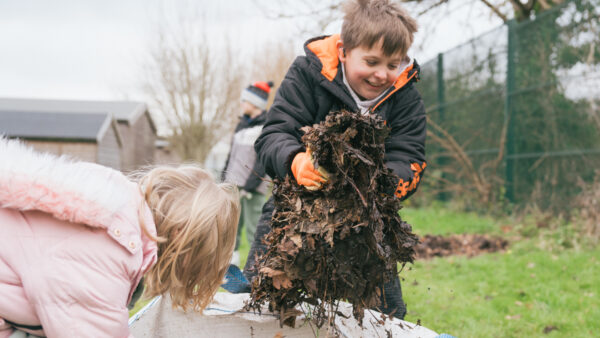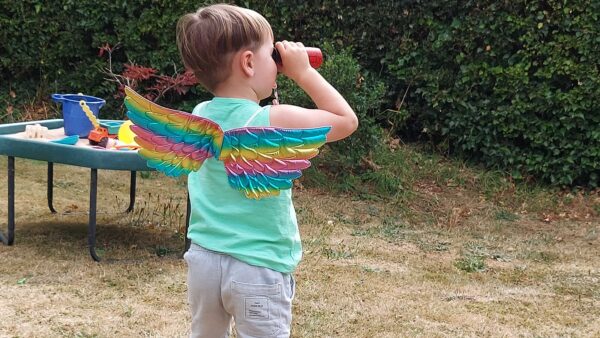When running family activities at your visitor destination it is important to think about what the needs of those families might be, and how you can best accommodate everyone. This will make sure that everyone can have a great experience and not miss any of the opportunities you have provided.
A useful way to think about the experiences people will have is to use the Access Chain, a tool developed by the Sensory Trust.
By considering each link in the access chain you can work through the different experiences on offer. It is easy to begin your focus on what happens during the actual activity, but as you can see from the access chain there is a lot to consider before you even get to that. How do people know the activity is available to them for example.
How will people find out about your site?
Are you promoting it through places that families will be looking at? If you can have a relationship with local groups or specialist schools in your area, then you can ask to share information through their preferred channels for example Facebook groups or in newsletters.
Your website is a good place to start
Is it accessible? It can feel like there is so much to say to make sure you accommodate everyone’s needs. On your visitor pages find a way to have layers of information that people can access if relevant to them. It is not important for everyone to know where the water bowls are for assistance dogs but for some it is one of the most important things to know.
Consider the journey people take through your information to get what is important to them. Access to this pre visit information is crucial for decision making before a visit. Perhaps people contact you via the phone. If this is the case, then you need to ensure your staff have had the correct training to be able to support any enquiries. Disability and diversity training is widely available and those that deliver such training will be able to help give a general understanding and should also be able to give more bespoke advice for your setting.
Think about why people would want to visit
What is it that makes your place special? Is that accessible to everyone? If there is an actual activity; a talk, games, an exhibition, what time are they happening, how long do they run for, is there seating, is it noisy?
Think about the different aspects that might impact on someone’s visit and how you let people know about that, both before they visit (pre visit information, promotional materials) and when they are there.
Accessible facilities are a big deal
The more information you can share about that the better it is for everyone, no surprises when you arrive. The main things to consider are your parking facilities, toilets, a cup of tea and what there is to do – the experience. It may be true that no one has ever visited a place because there is excellent parking, but it does make a huge difference to your experience.
All settings should have good accessible parking with a clear route to the entrance. Do you have drop off points if the main parking is some distance to the entrance? Is there seating and shelter at that drop off point where people can be comfortable whilst waiting for friends or family to park the car? Are your parking spaces clearly marked and designated? Car parking standards and guidance can be found online.
Anyone working front of house for your site (if this is something you have) should be confident and prepared to answer questions on access. If they have had the relevant training this will not be an issue. It is also important to share any onsite activities with everyone in the organisation, so everyone is aware of what is on offer. For example, if you have a plant in flower that is scented or a signed story performance this might be something you wish to share when visitors arrive. Making sure this information is shared between site staff is important for what you can tell your visitors.
Toilets are a major concern for most visitors
It is not always something that people want to openly discuss but it can make a huge difference to an experience. Information is the key on this. If you can share what toilet facilities you have through your pre-visit information then there are no surprises when people arrive. Having clear signage around your site telling people what toilets there are and where to find them. If you need to understand exactly what an accessible toilet is, or the specifics it needs to qualify, there is guidance online that can help with that. A changing places facility will open your site to many more people, this is a great facility to have and details of them can be found at changing-places.org Guidance is also available to help you create the best facilities you can, if you can offer a range of toilets; accessible, semi ambulant, gender neutral, male, female, left and right sided accessible toilets then you will be able to include more visitors. Think about what you can offer and how you let people know. If you have scope to make changes or improvements you can assess what is important and what will have the most impact.
Having onsite café facilities is a great plus to a visit but it is not always an expectation
Again, if visitors know there will not be anything available they can plan their visit accordingly. If you can offer refreshments then think about how people use the space, and the access and egress to a facility. Have the staff running the facility had disability and diversity training? Are they confident in accommodating all visitors?
In a cafe setting consider whether the information you offer is accessible, the menus, special boards, are you using an accessible font in a good size? Do the staff understand allergies and intolerances of different foods? If people order at a counter do you have a dropped counter for wheelchair users or people of short stature?
Inclusive activities are better for everyone
If you are unsure what your site has to offer for visitors with disabilities, impairments or health issues then there are a few things you can do to make sure you are offering the best experience possible. You could work with disability groups in your area to help you assess and understand what the experience is like when visiting your site with a disability. You may have staff and volunteers who are also able to help with this. Explore your site to understand the sensory highlights, (this may change through the seasons or when activities, live programmes change). Use a sensory checklist of what senses are being stimulated at different points, this is a simple way to ensure you have something on offer for everyone.
Once you begin to look at what you have on offer and how you communicate that it can be very rewarding to see the diverse opportunities that exist. It can also be quite straightforward to see how with a few simple changes the offer can be expanded to encompass even more, offering an even greater experience for everyone.
Sensory Trust offer plenty of guidance and help online, and training for disability and diversity awareness. Local groups can also offer support and advice. The more inclusive and accessible your site can be the better it is for everyone. We rarely go out alone and any experience we have is often shared by our friends and families. We all want a good time and we are all entitled to have one!



